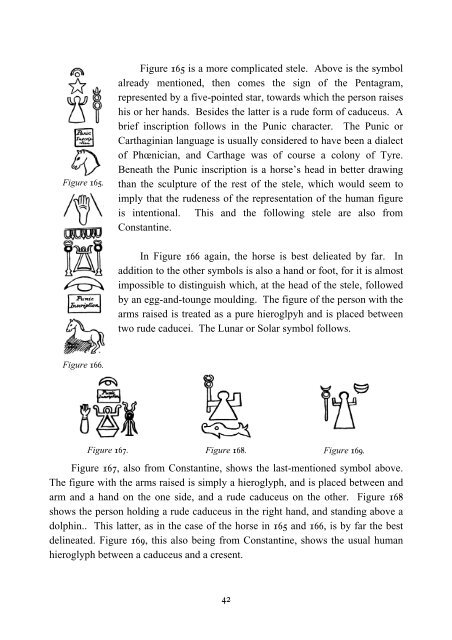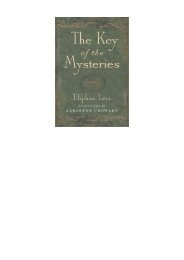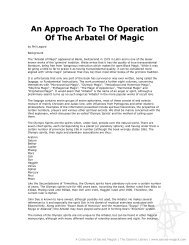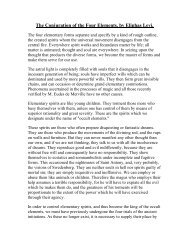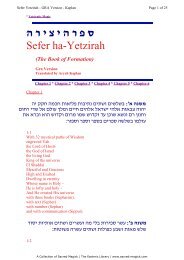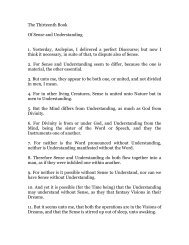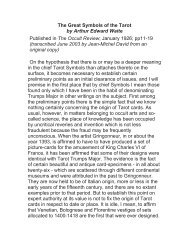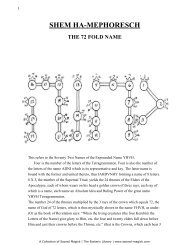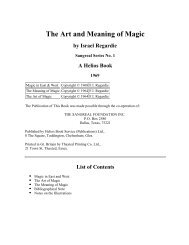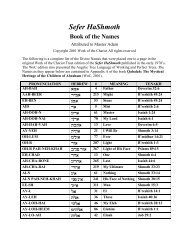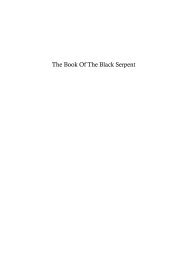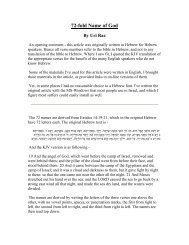Goetia - Holy Order of the Golden Dawn Canada
Goetia - Holy Order of the Golden Dawn Canada
Goetia - Holy Order of the Golden Dawn Canada
Create successful ePaper yourself
Turn your PDF publications into a flip-book with our unique Google optimized e-Paper software.
Figure 165.<br />
Figure 165 is a more complicated stele. Above is <strong>the</strong> symbol<br />
already mentioned, <strong>the</strong>n comes <strong>the</strong> sign <strong>of</strong> <strong>the</strong> Pentagram,<br />
represented by a five-pointed star, towards which <strong>the</strong> person raises<br />
his or her hands. Besides <strong>the</strong> latter is a rude form <strong>of</strong> caduceus. A<br />
brief inscription follows in <strong>the</strong> Punic character. The Punic or<br />
Carthaginian language is usually considered to have been a dialect<br />
<strong>of</strong> Phœnician, and Carthage was <strong>of</strong> course a colony <strong>of</strong> Tyre.<br />
Beneath <strong>the</strong> Punic inscription is a horse’s head in better drawing<br />
than <strong>the</strong> sculpture <strong>of</strong> <strong>the</strong> rest <strong>of</strong> <strong>the</strong> stele, which would seem to<br />
imply that <strong>the</strong> rudeness <strong>of</strong> <strong>the</strong> representation <strong>of</strong> <strong>the</strong> human figure<br />
is intentional. This and <strong>the</strong> following stele are also from<br />
Constantine.<br />
In Figure 166 again, <strong>the</strong> horse is best delieated by far. In<br />
addition to <strong>the</strong> o<strong>the</strong>r symbols is also a hand or foot, for it is almost<br />
impossible to distinguish which, at <strong>the</strong> head <strong>of</strong> <strong>the</strong> stele, followed<br />
by an egg-and-tounge moulding. The figure <strong>of</strong> <strong>the</strong> person with <strong>the</strong><br />
arms raised is treated as a pure hieroglpyh and is placed between<br />
two rude caducei. The Lunar or Solar symbol follows.<br />
Figure 166.<br />
Figure 167. Figure 168. Figure 169.<br />
Figure 167, also from Constantine, shows <strong>the</strong> last-mentioned symbol above.<br />
The figure with <strong>the</strong> arms raised is simply a hieroglyph, and is placed between and<br />
arm and a hand on <strong>the</strong> one side, and a rude caduceus on <strong>the</strong> o<strong>the</strong>r. Figure 168<br />
shows <strong>the</strong> person holding a rude caduceus in <strong>the</strong> right hand, and standing above a<br />
dolphin.. This latter, as in <strong>the</strong> case <strong>of</strong> <strong>the</strong> horse in 165 and 166, is by far <strong>the</strong> best<br />
delineated. Figure 169, this also being from Constantine, shows <strong>the</strong> usual human<br />
hieroglyph between a caduceus and a cresent.<br />
42


